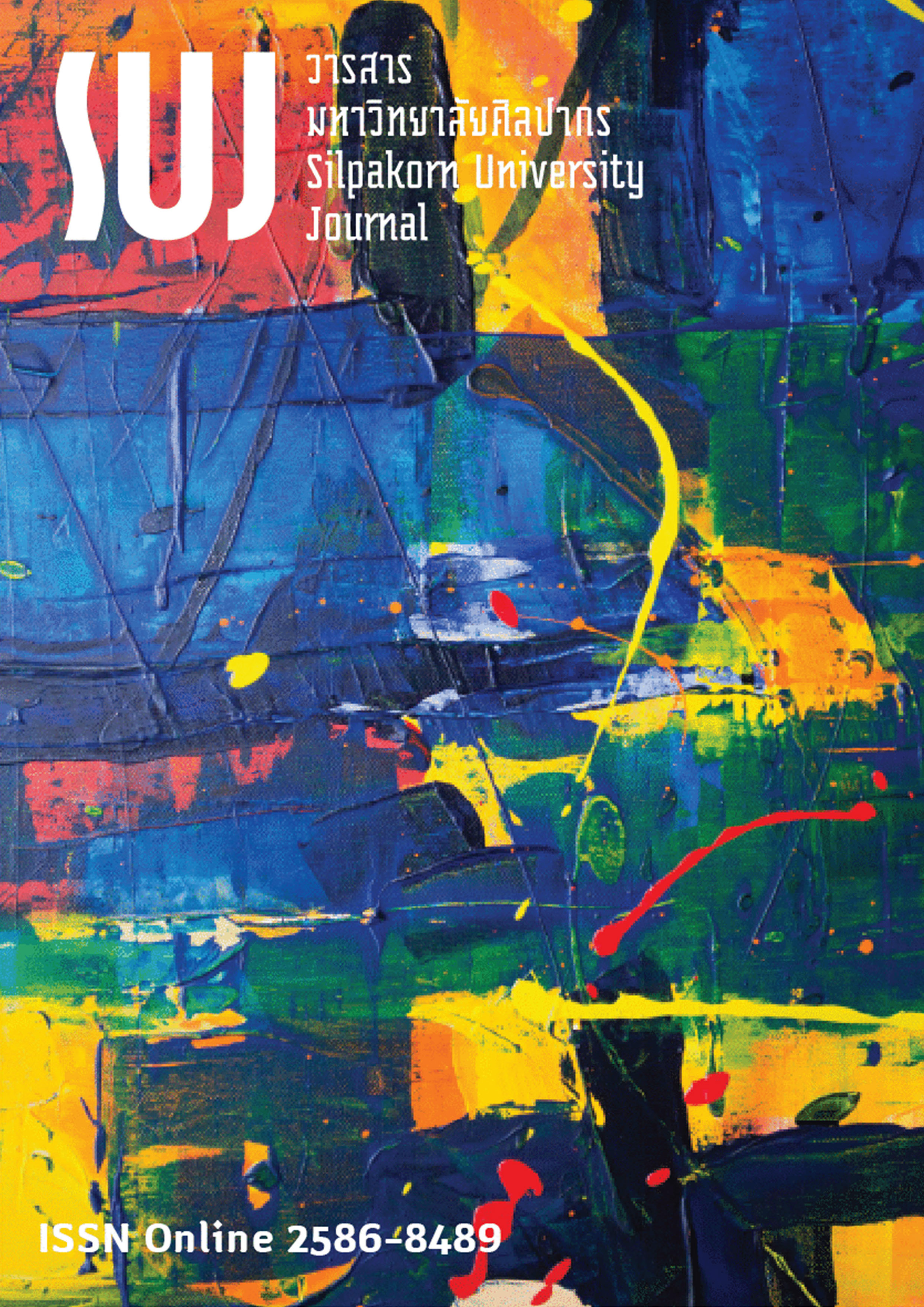การพัฒนาสื่อออนไลน์เพื่อป้องกันการใช้ความรุนแรงของเด็กวัยรุ่น (The development of online media to prevent youth violence)
Main Article Content
Abstract
การพัฒนาสื่อออนไลน์เพื่อป้องกันการใช้ความรุนแรงของเด็กวัยรุ่น ดำเนินการในรูปแบบการวิจัยและพัฒนา มีวัตถุประสงค์ของการวิจัย 1) เพื่อพัฒนาสื่อออนไลน์ในรูปแบบโมชันอินโฟกราฟิกในการป้องกันการใช้ความรุนแรงสำหรับเด็กวัยรุ่น 2) เพื่อประเมินประสิทธิภาพสื่อออนไลน์ในรูปแบบโมชันอินโฟกราฟิกในการป้องกันการใช้ความรุนแรงสำหรับเด็กวัยรุ่น 3) เพื่อศึกษาผลสัมฤทธิ์ทางการเรียนและศึกษาความพึงพอใจของนักเรียนต่อสื่อออนไลน์ในรูปแบบโมชันอินโฟกราฟิกในการป้องกันการใช้ความรุนแรงสำหรับเด็กวัยรุ่น และ 4) เพื่อนำเสนอแนวทางการเผยแพร่สื่อออนไลน์ในรูปแบบโมชันอินโฟกราฟิกในการป้องกันการใช้ความรุนแรงสำหรับเด็กวัยรุ่น กลุ่มตัวอย่างที่ใช้ในการวิจัยครั้งนี้ได้มาโดยการเลือกแบบเจาะจง ประกอบด้วย เด็กวัยรุ่น ผู้บริหารโรงเรียน ครูในโรงเรียน และเจ้าหน้าที่หน่วยงานรณรงค์ป้องกันการใช้ความรุนแรง รวมทั้งสิ้น 97 คน เครื่องมือที่ใช้ คือ แบบสัมภาษณ์ ชุดสื่อออนไลน์ในรูปแบบโมชันอินโฟกราฟิก แบบประเมินสื่อ แบบทดสอบวัดผลสัมฤทธิ์ทางการเรียน และแบบประเมินความพึงพอใจ ผลการวิจัยพบว่า 1) สื่อที่เหมาะสมในการป้องกันความรุนแรง ควรเป็นสื่อออนไลน์ที่เข้าถึงง่าย มีเนื้อหาน่าสนใจ น่าติดตาม เหมาะสมกับเพศและวัย เป็นสื่อเพื่อให้ความรู้กับวัยรุ่น ครอบครัว ผู้บริหารและครูในโรงเรียน โดยมีองค์ประกอบด้านเนื้อหาเกี่ยวกับพัฒนาการวัยรุ่น ทักษะป้องกันความรุนแรง การสื่อสารเชิงบวก ความเข้าใจสาเหตุของความรุนแรงและทักษะของผู้ช่วยเหลือ 2) สื่อออนไลน์มีประสิทธิภาพ 80.32/82.40 ตามเกณฑ์มาตรฐาน 80/80 ที่กำหนดไว้ 3) ผลสัมฤทธิ์ทางการเรียนโดยคะแนนหลังเรียนสูงกว่าก่อนเรียนอย่างมีนัยสำคัญทางสถิติที่ระดับ 0.05 ซึ่งเป็นไปตามสมมติฐานที่ตั้งไว้ ผลประเมินความพึงพอใจของนักเรียนต่อสื่อออนไลน์มีระดับความพึงพอใจมากที่สุด และ 4) ได้แนวทางการเผยแพร่สื่อออนไลน์ ซึ่งทำได้โดยทำหนังสือแจ้งและส่งชุดโครงการสื่อให้หน่วยงานการศึกษาที่เกี่ยวข้อง หน่วยงานทางสาธารณสุขจังหวัด สถาบันแห่งชาติเพื่อการพัฒนาเด็กและครอบครัว รวมถึงมูลนิธิสร้างเสริมความปลอดภัยในเด็ก และทำการเผยแพร่ในสื่อสังคมออนไลน์
The development of online media to prevent violence in adolescents carried out in the form of research and development aimed to 1) develop online media in motion infographics to prevent youth violence; 2) evaluate the effectiveness of online media in motion infographics; 3) study academic achievement and students’ satisfaction with online media in motion infographics; and 4) introduce guidelines for disseminating online media in motion infographics. The research samples were selected by purposive sampling consisting of adolescents, school administrators, school teachers, and officers from the anti-youth violence campaign units, totaling 97 people. The research tools included interview forms, online media in motion infographic forms, media evaluation forms, achievement tests, and satisfaction assessment forms. The results revealed that 1) proper online media to prevent violence should be easy to access, full of interesting and engaging content, and suitable for all genders and ages. The media should educate adolescents, families, school administrators, and teachers. It should include content on adolescents’ development, anti-violence skills, positive communication, understanding the causes of violence, and skills for victim rescuers; 2) The efficiency of online media was 80.32/82.40 according to the established 80/80 benchmark; 3) The posttest achievement scores were higher than pretest ones at the 0.05 level which was in line with the hypothesis. The results of students’ satisfaction with online media had the highest level of satisfaction; 4). The suggested guidelines for disseminating online media were to send a written notice and online media project packages to the relevant education organizations, provincial public health organizations, the National Institute for Child and Family Development, the foundation for child safety promotion, and to publish on social media.
Downloads
Article Details

This work is licensed under a Creative Commons Attribution-NonCommercial-NoDerivatives 4.0 International License.
References
Dhanasobhon, Somtawil. (2008). Development of Electronic Learning Resources on Violence Prevention for the Adolescents (การพัฒนาทรัพยากรการเรียนรู้อิเล็กทรอนิกส์เพื่อป้องกันความรุนแรงสำหรับเด็กวัยรุ่น). [Online]. Retrieved February 11, 2019 from http://www.thaiedresearch.org/index.php/home/paperview/157/?topicid=10
Gunmintra, Chalasai. (2019). Domestic Violence: Problems and Prevention (ความรุนแรงในครอบครัว: ปัญหาและแนวทางป้องกัน). In Proceedings of RSU Research Conference, (pp. 984-997). Pathum Thani: Rangsit University.
Kaewsuksai, Rawi, & Jussapalo, Chairat. (2013). Online social network: Facebook usage for the learners’ development (เครือข่ายสังคมออนไลน์ : กรณี เฟสบุ๊ค (Facebook) กับการพัฒนาผู้เรียน). Princess of Naradhiwas University Journal, 5(4): 195-205.
Kesa, Sa-edah, & Jitpiromsri, Srisompob. (2015). Adolescent and cultural violent in Muang district, Satun province (วัยรุ่นกับความรุนแรงเชิงวัฒนธรรมในอำเภอเมือง จังหวัดสตูล). Parichart Journal, 28(3): 154-166.
Lomchavakarn, Piyachat. (2021). The media aimed to reduce domestic violence (สื่อที่ทำให้ความรุนแรงในครอบครัวไทยลดลง). STOU Academic Journal of Research and Innovation (Humanities and Social Science), 1(1): 11-20.
Mingsiritham, Kemmanat. (2013). Social media: Creative media for education (Social Media สื่อสร้างสรรค์เพื่อการศึกษา). Veridian E-Journal, Silpakorn University (Humanities, Social Sciences and Arts), 6(1): 72-81.
Morris, C. (2004). Conflict Management and Apology (การจัดการความขัดแย้งและการขอโทษ). Bangkok: King Prajadhipok’s Institute.
Rattanajirapong, Pathitta. (2017). Factors Effecting the Violence Behavior of Male Students in Vocational College in Nakhon Pathom Province (ปัจจัยที่ส่งผลต่อพฤติกรรมการกระทำรุนแรงของนักเรียนชายอาชีวศึกษาในจังหวัดนครปฐม). Master’s dissertation, Silpakorn University, Nakhon Pathom, Thailland.
Satha-Anand, Chaiwat. (1996). Peace Theory, Way of Culture (สันติทฤษฎี วิถีวัฒนธรรม). Bangkok: Komol Keem Thong Foundation.
Social Development News Team. (2019). Unlocking Violent Behavior : ACT promote protection of the family, gap filling mechanism (ปลดล็อกความรุนแรง : เจาะ พ.ร.บ. ส่งเสริมคุ้มครองครอบครัวอุดช่องว่างเสริมกลไกการทำงาน). Thairath Online. [Online]. Retrieved August 1, 2019 from https://www.thairath.co.th/news/local/1593806
Visanuyothin, Taweesin, & Arunruang, Patcharin. (2013). Guidelines to Help Adolescents with Violent Behavior for Public Health Officer (แนวทางการดูแลช่วยเหลือวัยรุ่นที่มีพฤติกรรมความรุนแรงสำหรับบุคลากรสาธารณสุข). Bangkok: Deenadoo Media Plus.


